Some call it a gift. Others, a symbol. At Diamond Bakery, we simply call it honoring. We are celebrating Lei throughout the month of May as we honor and show our appreciation for Diamond Bakery customers.
The history of the Hawaiian lei dates back to the first Polynesian settlers, who introduced the lei to the Hawaiian Islands as a sentiment of love, friendship, celebration, honor, or greeting. In other words, a symbol of aloha. All around Hawaii, you’ll find leis everywhere — graduations, parties, dances, weddings, and yes, even at the office. Any occasion can be considered special and “lei-worthy.”
The custom of the flower lei was introduced to Hawaii from the various surrounding Polynesian islands and even Asia. In ancient Hawaii, wearing a lei represented wealth, royalty, and rank. Leis were also heavily associated with hula, religion, and geography. It is said that ancient Hawaiians adorned themselves in variations of braided leaves, flowers, feathers, shells, seeds, and nuts to differentiate the various classes of royalty. The most significant of all was the Maile lei, which was used as peace offerings between battling chiefs and on sacred events such as weddings, ceremonies, and rituals. The royalty and Hawaiian chieftains favored the fiery, vibrant Ilima — a thin orange blossom that requires hundreds of flowers to make a single lei strand. Hawaiian Princess Kaiulani’s favorite lei was the Pikake, named after the peacocks in her garden, for the heavenly white blossoms and sweet jasmine fragrance.
The state of Hawaii consists of eight major islands. Each island has its own designated lei which represents a harmonious marriage of texture and color. Most of these leis are unavailable for shipping to the mainland due to strict agricultural laws.
- Hawaii – Lehua
- Oahu – Ilima
- Maui – Lokelani
- Kauai – Mokihana
- Molokai – Kukui
- Lanai – Kaunaoa
- Niihau – Pupu
Crafted by hand and carefully woven, these fragrant beauties are treasured by all and are now worn for just about any occasion. Today, popular events like Lei Day, which is celebrated on the 1st of each May, honor lei making and its customs with lei contests, traditional hula, and Hawaiian music. The first May Day / Lei Day was on May 1, 1928. Since then, Hawaii has celebrated every May first as its official “Lei Day.” The flower lei is celebrated passionately on that day with Hula, parades, and music. Children participate in May Day festivities and programs at school, and everyone in Hawaii is encouraged to wear a lei on May Day.
Lei Etiquette
Leis can be worn, received, or given for almost any occasion. In Hawaii, a lei is given for an office promotion, a birthday, an anniversary, a graduation, or any special event. Yet more notably, a lei can be worn for no other reason than to enjoy the fragrance, take pleasure in the beautiful flowers, or simply, celebrate the “Aloha Spirit.”
There is one faux pas to consider. Never refuse a lei! Always graciously accept the lei with a smile and a kiss on the cheek or a warm hug. If you are allergic or sensitive to flowers, then discreetly and apologetically slip off the lei. It is acceptable and considered a kind gesture to offer the lei to your spouse if you are unable to wear it.
Last but not least, there is one more taboo…it is considered (in Hawaii) impolite to give a closed (tied) lei to a pregnant woman. Many Hawaiians feel that a closed lei around the neck is bad luck for the unborn child. (Haku (head) lei and open-ended leis are acceptable to give to pregnant women.)
Legends say if a departing visitor tosses their lei into the ocean and it floats back to shore, the person will return one day. We hope you are able to visit Hawaii again soon, but until then, you can get a taste of the islands (and local favorites) from our online store, diamondbakery.com.





